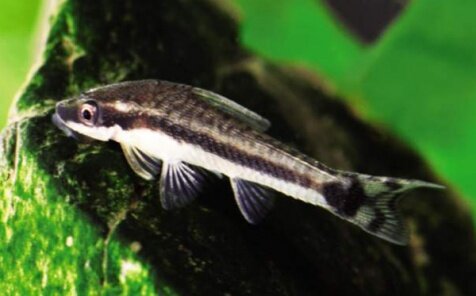Dwarf Suckermouth
From Microcosm Aquarium Explorer

An industrious little grazer always best kept in groups of at least three. Aaron Norman
Overview
Members of the genus Otocinclus are busy little fishes and nothing if not thorough when it comes to suctioning leaves and other substrate of green algae. They can be especially useful in cleaning the leaves of small and delicate plants, including the Madagascar Lace Plant (Aponogeton madagascariensis).
Several similar species, including the Golden Dwarf Suckermouth (O. affinis) are often available.
Family: Loricariidae
Other common name(s):
- Otocinclus Catfish
Native range:
Habitat: Keep in an aquarium with wide-leaved plants, such as Echinodorus, with plenty of driftwood on which the catfish can browse as well. Provide a smooth, rounded gravel substrate, as they also search the substrate for food.
Maximum length: 3.3 cm (1 in)
Minimum aquarium size: 38 L (10 gal)
Water: Freshwater 22 °C (72 °F) - 26 °C (79 °F)
General swimming level: Bottom and on all substrates.
Feeding
A common mistake is assuming that because the Dwarf Suckermouth eats algae in nature, it can survive with no additional feedings in the aquarium. This is, in fact, not true, and many an Otocinclus has paid the price. Feed a varied diet of commercial flake, pelleted and sinking wafers designed for suckermouth catfishes, as well as garden vegetables sunk to the bottom. Feed first thing in the morning and just after the lights go out at night.
Aquarium Compatibility
The Dwarf Suckermouth should be kept in groups of at least three in mostly peaceful, planted community aquarium settings.
Breeding/Propagation
Spawn much like Corydoras, on just about any surface—glass, rock, leaf—onto which they can place their adhesive spawn. Afterwards, there is no parental care of the eggs.








